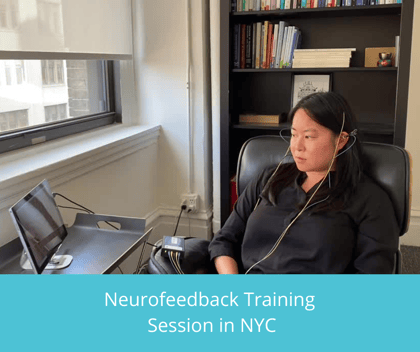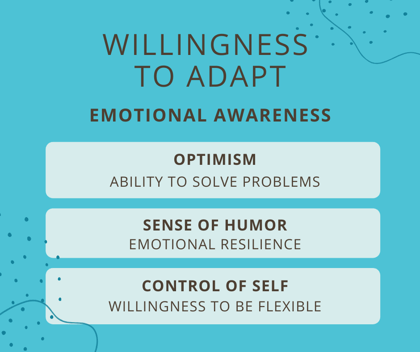During the last 8+ months as a NeurOptimal® trainer and trainee, I’ve often tried to visualize different analogies for how neurofeedback works. Since the brain functions and communicates through electrical patterns and their interactions, one of the most striking images that comes to mind are ripples in a body of water. Just like electrical interactions, ripples collide with each other, making some patterns larger and extinguishing others. When patterns are habitually repeated and become rigid, they are like whirlpools that can get stuck in motion. Neurofeedback is like dropping precisely timed stones into the water to disrupt existing patterns, giving them the chance to reorganize more efficiently. This disruption is what leads to flexibility and resilience.
top three changes from neurofeedback training that I’ve noticed:
 Training at least once a week over several months, the effects of NeurOptimal® neurofeedback have been profound, without which I wouldn’t have experienced the physical, emotional, and cognitive changes I’ve undergone. I believe that it helped me to grow across multiple planes and accelerate peak performance in both emotional and cognitive arenas. Though it is the culmination of sessions over time that really leads to noticing significant changes, there are times after a single session where I notice a shift, often associated with the stress response. It feels like a weight being dropped after carrying it unnecessarily. This reaction of lightening up makes sense as neurofeedback brings the brain back into each present moment, releasing the heaviness of my flight/ fight response and focusing its attention on the present. As I have been training I notice that there can be a loosening of tension and a feeling of clarity and lightness. Sometimes for me, this relaxation and clarity leads to new insights or inspiration to arise.
Training at least once a week over several months, the effects of NeurOptimal® neurofeedback have been profound, without which I wouldn’t have experienced the physical, emotional, and cognitive changes I’ve undergone. I believe that it helped me to grow across multiple planes and accelerate peak performance in both emotional and cognitive arenas. Though it is the culmination of sessions over time that really leads to noticing significant changes, there are times after a single session where I notice a shift, often associated with the stress response. It feels like a weight being dropped after carrying it unnecessarily. This reaction of lightening up makes sense as neurofeedback brings the brain back into each present moment, releasing the heaviness of my flight/ fight response and focusing its attention on the present. As I have been training I notice that there can be a loosening of tension and a feeling of clarity and lightness. Sometimes for me, this relaxation and clarity leads to new insights or inspiration to arise.
[Photo: NeurOptimal® trainer and trainee Amy at the NYC Neurofeedback Training Co. office]
1. Emotional Resilience
.png?width=420&name=what%20is%20emotional%20resilience%20graphic%20(2).png) Neurofeedback has helped me to gain and accelerate my emotional resilience. When strong emotions come up, I find myself better able to be more present and non-judgmental with them, letting them pass through me rather than getting stuck. This resourcing has led me to acknowledge uncomfortable emotions and observe them as they are.
Neurofeedback has helped me to gain and accelerate my emotional resilience. When strong emotions come up, I find myself better able to be more present and non-judgmental with them, letting them pass through me rather than getting stuck. This resourcing has led me to acknowledge uncomfortable emotions and observe them as they are.
Additionally, I find myself less reactive and more grounded. Unpredictable stress can find us in the most inconvenient of times - from family emergencies to misplacing keys. When I encounter such stress, I’m much more able to take a step back from the emotion I feel—anger, sadness, irritability—and observe the situation as though from an outsider perspective. I am reminded of the last two lines of a poem by Emily Dickinson:
"Powder exists in charcoal - Before it exists in fire - "
Essentially, we can step back from an emotion before following through. This can be compared to an interruption in music during a NeurOptimal® session – interrupting instead of immediately becoming our emotions. Neurofeedback has allowed me to encounter my feelings with a heightened openness and curiosity.
2. Reduced Mental Rumination
 NeurOptimal® is designed to nudge the brain to become “unsticky.” What I mean by this is breaking thought patterns that tend to be persistent and repetitive. These thoughts can be unconscious, emotionally charged beliefs, or all-encompassing narratives about the self and others.
NeurOptimal® is designed to nudge the brain to become “unsticky.” What I mean by this is breaking thought patterns that tend to be persistent and repetitive. These thoughts can be unconscious, emotionally charged beliefs, or all-encompassing narratives about the self and others.
For me, neurofeedback has given me a boost in being able to see thoughts and let them go with less judgement, and to continuously revise the stories I tell myself that affect my everyday reality. We all carry assumptions based on previous experiences and I’m better able to take a step back from the initial judgement and ask myself, “Is there another way to see the present moment?” This shift from reactive to being aware has helped to reduce anxious thinking or imagining worst-case scenarios. By having the mental space, I can more easily let go of unproductive beliefs. In addition, I have more compassion and patience for others and disagreeable situations. Falling into the loops of mental and emotional rumination is something neurofeedback has helped to interrupt.
[Photo: The view while in session at the NYC Neurofeeback Training Co. clinic on Manhattan. Watch a Tour of our NYC Neurofeedback Office ]
Related:
3. Heightened Creativity

In my own practice with creativity, I am particularly drawn to the artistic process and how ideas flow and morph into a visual representation. When creating art for example, it is really interesting how one idea can quickly become obsolete, and another takes hold. Neurofeedback has helped train the muscle of weighing options loosely, effectively leading to possibility. The act of weighing possibilities can happen many times during a single project. Getting too confident or attached to one idea can lead to creative block. In many aspects, the process of creativity is like the process of neurofeedback: breaking patterns to make way for something new. Disrupting thoughts is like turning a kaleidoscope: new patterns and organizations arrive, perhaps even more beautiful than before.
 Clients have expressed how wonderful the view is looking at New York City from the neurofeedback chair in our office. This re-imagined rendition is my take on it (made with a window screen as canvas, glue and printer ink). In my experience, NeurOptimal® and creativity go hand in hand.
Clients have expressed how wonderful the view is looking at New York City from the neurofeedback chair in our office. This re-imagined rendition is my take on it (made with a window screen as canvas, glue and printer ink). In my experience, NeurOptimal® and creativity go hand in hand.
What I love about NeurOptimal® is the creators', Drs. Sue and Valdeane Brown, language of elegance and simplicity for the seemingly complex and chaotic nature of the brain. What I find special about the technology is its ability to work with the brain without me consciously needing to interact with it. Feedback that surpasses the necessity of consciousness frees up time and space.
This design is profound and practical for those who have a busy work schedule (have a NeurOptimal® session while working!) or those who struggle with attention issues (and require another form of activity while doing a session like watching a video). Additionally, others who perhaps feel "consciously stuck" can use neurofeedback to bypass awareness and accelerate changes in combination with therapy.
 In the past, I worked with adults with intellectual and developmental disabilities who often communicated in ways other than with words when presenting their needs and opinions. I am reminded of this population because NeurOptimal® makes emotional and cognitive well-being widely accessible. Not only is the system diagnostically agnostic (meaning the feedback doesn’t rely on a diagnosis to have successful outcomes), it is also communicatively non-discriminatory, assuming one has the sensory capacity to receive the feedback. For those with disabilities, young children or those with other medical or neurological conditions that make it difficult to communicate with words, each brain can communicate with itself on the physiological level of electrical patterns. This communication option is profound: regardless of the brain, NeurOptimal® provides the communication to self-regulate and achieve well-being on that universal level. One thing to note, though, is that since feedback from NeurOptimal® is primarily auditory, one bears in mind the limitations and possibilities for the deaf community, although deaf clients have used NeurOptimal® using vibrations on the mastoid bone to 'hear' and have had good results! They feel the interruption in the music.
In the past, I worked with adults with intellectual and developmental disabilities who often communicated in ways other than with words when presenting their needs and opinions. I am reminded of this population because NeurOptimal® makes emotional and cognitive well-being widely accessible. Not only is the system diagnostically agnostic (meaning the feedback doesn’t rely on a diagnosis to have successful outcomes), it is also communicatively non-discriminatory, assuming one has the sensory capacity to receive the feedback. For those with disabilities, young children or those with other medical or neurological conditions that make it difficult to communicate with words, each brain can communicate with itself on the physiological level of electrical patterns. This communication option is profound: regardless of the brain, NeurOptimal® provides the communication to self-regulate and achieve well-being on that universal level. One thing to note, though, is that since feedback from NeurOptimal® is primarily auditory, one bears in mind the limitations and possibilities for the deaf community, although deaf clients have used NeurOptimal® using vibrations on the mastoid bone to 'hear' and have had good results! They feel the interruption in the music.
Related:
 In my journey I have come to experience neurofeedback as a powerful form of brain training, though not a panacea. There are many different tools related to optimal wellbeing: a good diet, sleep, a social circle, having a sense of purpose, etc. With the combination of other healthy habits, neurofeedback can help the brain stay sharp and adaptable, especially when stress strikes again. The beauty of NeurOptimal® lies in its effortless communication on a physical level, impacting my emotional and cognitive self, and ultimately helping me gain a sense of coherency and balance.
In my journey I have come to experience neurofeedback as a powerful form of brain training, though not a panacea. There are many different tools related to optimal wellbeing: a good diet, sleep, a social circle, having a sense of purpose, etc. With the combination of other healthy habits, neurofeedback can help the brain stay sharp and adaptable, especially when stress strikes again. The beauty of NeurOptimal® lies in its effortless communication on a physical level, impacting my emotional and cognitive self, and ultimately helping me gain a sense of coherency and balance.
Read more from Amy: